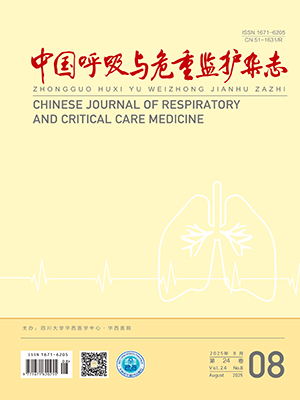Objective To explore the activity of Ca2 + -activated K+ ( KCa) inairwaysmoothmuscle cells( ASMCs) in a rat model of chronic obstructive pulmonary disease( COPD) , and to observe the effect of 11, 12-Epoxyeicosatrienoic acid( 11, 12-EETs) on the KCa channel of ASMCs. Methods Forty male Sprague-Dawley rats were randomly assigned to a COPD group and a normal control group. The rats in the COPD group were exposed to cigarette smoking in a relatively closed chamber to induce COPD. The ASMCs were isolated from small bronchi using an acute enzymatic digestion method. In the symmetrical high K+ solution,the KCa currents were separated with inside-out configuration using the patch clamp technique. The activity of KCa currents in ASMCs between the COPD group and the normal group were compared and the effect of 11, 12-EETs on KCa channel was recorded. The opening probability( Po) , opening time( To) and closing time ( Tc) of the KCa were measured. Results Compared with the normal group, Po of KCa in the COPD rats was much shorter ( 0. 084 ±0. 028 vs 0. 198 ±0. 029, P lt; 0. 01) , To was shorter [ ( 0. 732 ±0. 058) ms vs ( 1. 648 ±0. 152) ms, P lt; 0. 01] and Tc was longer[ ( 12. 259 ±2. 612) ms vs ( 6. 753 ±1. 237) ms, P lt;0. 01] . 11, 12-EETs can evoke the activity of KCa currents of ASMCs in the COPD rats while Po was increased( 0. 227 ±0. 059 vs 0. 084 ±0. 028, P lt; 0. 01) , To was much longer[ ( 2. 068 ±0. 064) ms vs ( 0. 732 ±0. 058) ms, P lt; 0. 01] , and Tc was shorter [ ( 4. 273 ±0. 978) ms vs ( 12. 259 ±2. 612) ms, P lt;0. 01] .Conclusions The results suggest that the decreasing of KCa activity plays an important role in the development of COPD. 11,12-EETs can directly evoke the activity of KCa channel in COPD rats, thus relax the airway smooth muscles.
Citation: XIAO Xinrong,PENG Huasheng,XU Xianhua,HU Meng,YAN Xiang,ZHANG Ru,SUN Meiqin.. Effects of 11,12- Epoxyeicosatrienoic Acids on Calcium-Activated Potassium Channel of Airway Smooth Muscle Cells in COPD Rats. Chinese Journal of Respiratory and Critical Care Medicine, 2009, 09(2): 122-126. doi: Copy
Copyright © the editorial department of Chinese Journal of Respiratory and Critical Care Medicine of West China Medical Publisher. All rights reserved




